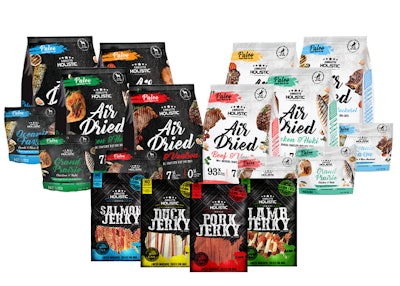
Global Pet Expo (GPE) always presents a great opportunity to meet and chat with people from throughout the pet food industry and see the latest trends – often in the form of pet food brands’ new product launches. This year’s show, held March 20-22 in Orlando, Florida, USA, and larger than ever, did not disappoint. Here are my key takeaways from very busy days on the show floor and conversations with pet food executives.
Top 3 pet food trends and new products
1. Air-dried foods from New Zealand. This concept is not new; I can remember seeing at least one launch of a new air-dried pet food line two years ago. This year I saw several; to name just a couple, Hagen has a new line of air-dried cat foods under its Catit brand, and Absolute Holistic, a company based in Singapore and just entering the U.S. market, was also touting an air-dried line for cats.
Though not exclusively for cats, these new lines seem focused on that species, and all are made in New Zealand. That country has long been known in the pet food world for its ingredients, especially proteins like lamb and venison; and its world-class university, Massey, has a strong companion animal research program. Perhaps this represents another pet food niche for the country?
2. Cats feeling lots of love. Speaking of cats, the number of new cat products and innovations seems to increase with every trade show I attend; at Global Pet Expo, it wasn’t just the air-dried products. Many of the pet food companies I met with, including more “traditional” ones such as Purina and Wellpet, were debuting just as many, if not more, new cat products as ones for dogs.
It’s understandable that many pet food companies have long focused much of their product development on dogs. There is a vastly greater variety among dogs than cats, with many breeds being larger – meaning they eat more and their owners spend more on them. Yet perhaps as people trend toward owning smaller dogs, pet food marketers are seeing the cat market as just as viable, possibly even more so because until recently it has been underserved. That creates more opportunities for innovation. (And as a cat owner, I can’t help but be pleased!)
3. Newer companies with alternative formats. This sub-category is certainly not new, either, but is growing quickly. As consumers seek less processing in their own foods and diets, some are also doing the same for their furry family members – and more new pet food companies are springing up offering foods that are raw frozen, gently cooked and fresh, baked, dehydrated, freeze dried and the aforementioned air dried. (To name just a few of the options.) That’s in addition, of course, to the pioneering companies that foresaw the coming consumer demand and tapped into it years ago.
Top 3 notable conversation points about pet food
1. Transparency. Champion Petfoods made the biggest splash in this area, announcing on March 21 a new Transparency Council, the industry’s first, according to the company. “This is a declaration that we feel good about who we are and what we stand for, including our ingredient sourcing and processes,” Don King, vice president of marketing, told me. The agreement with the council’s first four members, consisting of two veterinary experts and two pet lovers (the latter chosen through an application process), will be for just one year, but King said he sees the program continuing past that. “We just don’t know yet how it might evolve,” he added.
Aside from this initiative, the topic of transparency came up often in other conversations I had with pet food companies. Obviously, this is a positive development for our industry and especially for consumers, though I do worry that with some companies, transparency is more of a talking point or marketing claim than actual concrete action or change. Perhaps if Champion’s new council works well, other pet food companies will be inspired to develop similar programs.
2. Sustainability. More and more consumers are seeking sustainable ingredients, practices and processes in the products they buy, and pet food is no exception. This is especially true of millennials, now the largest pet-owning demographic in the U.S. What’s more, unlike in the past, more consumers seem willing to even pay a little more for sustainable products.
Pet food brands are paying attention and responding to this demand, going beyond just lip service and incorporating sustainability into many of their products, packaging and processes. The topic of sustainable packaging – completely recyclable, even compostable – came up several times in conversations on the GPE show floor. Most companies lamented that the technology and material to ensure safe, secure, shelf-stable yet fully sustainable packaging is not quite there yet, but they’re certainly not stopping their quest for it.
3. CBD all the time, everywhere. The CBD craze is real and has completely taken over the U.S. pet industry – despite the fact that this ingredient or related substances is not approved for use in pet foods or treats, and only marginally for pet supplements (if a company follows the recommendations and certification process of the National Animal Supplement Council). I talked with more than one person who believes that, because the U.S. Food and Drug Administration recently approved the cultivation of hemp crops, everything related is now legal, including for pet food. I tried to set them straight, though I fear my explanations fell on deaf ears.
A couple of executives from private label pet food manufacturers told me they’ve had clients asking about incorporating CBD in their pet foods or treats; these companies have (wisely) told them they can’t do that. Yet.
Pet food spending to surpass US$31 billion in 2019
All this product innovation and dynamic conversation is paying off. During GPE, the organizer, American Pet Products Association (APPA), released its annual pet industry spending report. In 2018, U.S. pet owners spent US$72.56 billion on their pets, with U.S.$30.32 billion going to pet food. Both figures represented more than 4 percent growth over 2017. APPA estimates that overall industry spending will increase another 3.9 percent in 2019, reaching a total of US$75.38 million by the end of the year, with pet food hitting US$31.68 billion, a 4.5 percent rise.















